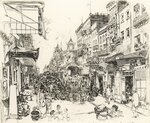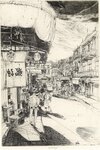

Featuring 81 etchings from American-Austrian artist John W. Winkler, a new exhibition at the Charles B. Wang Center at Stony Brook University explores scenes of San Francisco’s Chinatown in the early 20th century.
On view through May 19 as part of the Asian American Pacific Islander Heritage Month programming, “John W. Winkler: The Chinatown Etchings” was curated by physicist and art collector Rex Rivolo, with all works on loan from the A. Rex Rivolo Collection and the Martin Levine Collection.
Born in 1984 in a military family in Vienna, Austria, Winkler used a forged passport to move to San Francisco by himself at the age of 16. In 1912, he enrolled in the Mark Hopkins Institute, now known as the San Francisco Art Institute, where he was introduced to the art of etching. In a lecture at the Wang Center on Wednesday, March 20, Rivolo said that newspaper accounts at the time were fast to acknowledge Winkler as a “rising star.”
“Very quickly, he is recognized as a great artist in the medium,” Rivolo said.
To financially support his art, Winkler started lighting gas lamps in San Francisco’s Chinatown. He soon found great inspiration there, making over 100 etchings that illustrated the daily life of its residents.
In his lecture, Rivolo said Winkler had a fierce sense of fraternity with the Chinese community, as they shared a feeling of exclusion. Having a strong German accent in his speech, Winkler often felt ostracized in the United States, as there was a predominant anti-German sentiment in the country due to World War I. This feeling of ostracization was something that the Chinese community in the U.S. had been experiencing since the late 19th century.
Through his etchings, Winkler documented what it was like to be a part of San Francisco’s Chinese community in a pivotal period of Chinese immigration in the United States. Serving as a historical archive, these works of art not only showcase Winkler’s exceptional artistic skills, but also the deep connection he developed with his subjects.
“He had a very close bond with the Chinese community, and it comes across in all of his art,” Rivolo said.
This connection becomes explicit in the casualness of the subjects that he portrayed, such as grocery stores, teel wagons and fruit stands. Many of his etchings have titles that are simple yet accurate descriptions of their themes—for example, “Night in Chinatown with Lighted Windows,” “Dark Alley,” “Fish Market” and “Street Scene.”
“Busy Day in Chinatown,” from 1919, shows exactly what its title suggests: what a busy day in Chinatown was like. People stand in the street, some doing commerce while others only observe. On the left bottom corner, a cat licks itself while sitting on a window. On the top right corner, a woman stands on her balcony carrying a baby. A teel wagon is parked on the side of the street and people work around it, probably loading or unloading it. It’s impossible to describe every element of it. Curiously, this isn’t the only etching with this title. In “Busy Day in Chinatown,” from 1918, Winkler inserted himself in the etching. It’s possible to see him with a plate and needle in hand standing next to a woman with two children.
In addition to a rich representation of how vivid Chinatown life was, these etchings serve as great examples of how Winkler benefited from depth in his work. Differently from most etchings, which normally look flat, Winkler’s works have a three-dimensional aspect to them. By portraying the streets in their entire extent, Winkler invites the viewer to investigate more than just what is in the foreground.
“The image is meant to bring you into Chinatown, and it does exactly that,” Rivolo said.
Considered by many as his masterpiece, “The Delicatessen Maker” portrays a man working inside what seems to be a tent while figures stand in the street in the background. Besides the smart composition, this etching plays with a wonderful light and shadow contrast. Both the print and the original copper plate that were used to make it are on view at the Wang Center exhibition.
Winkler’s time in San Francisco’s Chinatown was the most productive period of his career. Struggling with mental health issues, he moved to France, then to England, and then back to California. Although very talented, Winkler never achieved financial success through his etchings. Still, he never stopped doing them. The pleasure of the artistic process was what drove him. This exhibition is a perfect demonstration of that.
Rafael Cruvinel is a senior journalism major and creative writing and literature minor at Stony Brook University. He is the arts & cultural programs intern at the Charles B. Wang Center.
Comments
No comments on this item Please log in to comment by clicking here